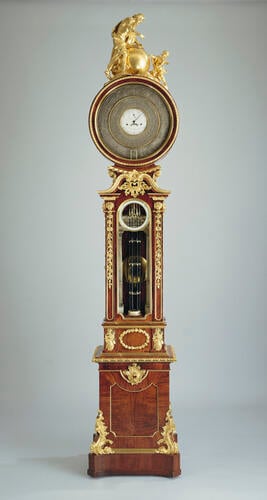-
1 of 253523 objects
Barometrical Clock 1763-65
Oak case with padouk veneer and gilt bronze mounts, ivory interior columns | 243.2 x 57.8 x 45.7 cm (whole object) | RCIN 2752
-
Clock driven barograph with rosewood and padouk case with ivory interior fitting and chased gilt bronze ornaments surmounting dial: an elderly male figure with book and putto. Floral swags suspended from lion masks decorate pilasters flanking barometer, military trophies below.
Among the substantial number of precision horological and scientific instruments that George III assembled at Buckingham House in the early part of the reign, this exceptional barograph is outstanding for both its mechanical complexity and the richness of its case. The movement was designed and made by the Scot, Alexander Cumming, and incorporates a month-going regulator clock with Cumming’s own escapement and an Ellicott compensating pendulum. A siphon wheel barometer in the trunk, supported between ivory Corinthian columns, is mechanically connected to the concentric six- and twelve-month charts which surround the clock dial.
The identity of Cumming’s cabinet-maker is unknown, but a likely candidate may be William Vile, with whose work the barograph case bears comparison, especially in the use of pierced gilt bronze angles (at the base) and pierced shell ornament (below the dial). The mount-maker (or makers, as more than one hand seems to have been involved) is equally unknown: the vividly modelled and finely chased drops of flowers at the angles of the trunk are of remarkable quality but quite different in character and finish to the martial trophies below. The origin of the gilt bronze group of the Creator assisted by Cupid has not been identified but John Flaxman the Elder (1726-95) and the elder John Bacon (1740-99) are known to have supplied the bronze trade with models of this general type, some of which were certainly used on clock cases.
George III kept the Cumming barograph, with the Pinchbeck astronomical clock, in the Passage Room of his apartments at Buckingham House where it was recorded for the Pictorial Inventory.
Inscribed on the upper dial: Alex Cumming London and GR; and on the lower dial ALEXANDER CUMMING LONDON
Catalogue entry adapted from George III & Queen Charlotte: Patronage, Collecting and Court Taste, London, 2004Provenance
This barograph cost George III the large sum of £1,178, to which he added a payment of £150 and an annual retainer to Cumming of £37 10s for maintaining the barograph. The King kept the Cumming barograph with the Pinchbeck astronomical clock in the Passage Room of his apartments at Buckingham House.
Included in the Pictorial Inventory of 1827-33 – RCIN 934885. The inventory was originally created as a record of the clocks, vases, candelabra and other miscellaneous items from Carlton House, as well as selected items from the stores at Buckingham House, the Royal Pavilion, Brighton, Hampton Court and Kensington Palace for consideration in the refurbishment of Windsor Castle.
-
Creator(s)
(clockmaker (movement))(nationality)Acquirer(s)
-
Medium and techniques
Oak case with padouk veneer and gilt bronze mounts, ivory interior columns
Measurements
243.2 x 57.8 x 45.7 cm (whole object)
Alternative title(s)
Floor standing clock, barometer and barograph

